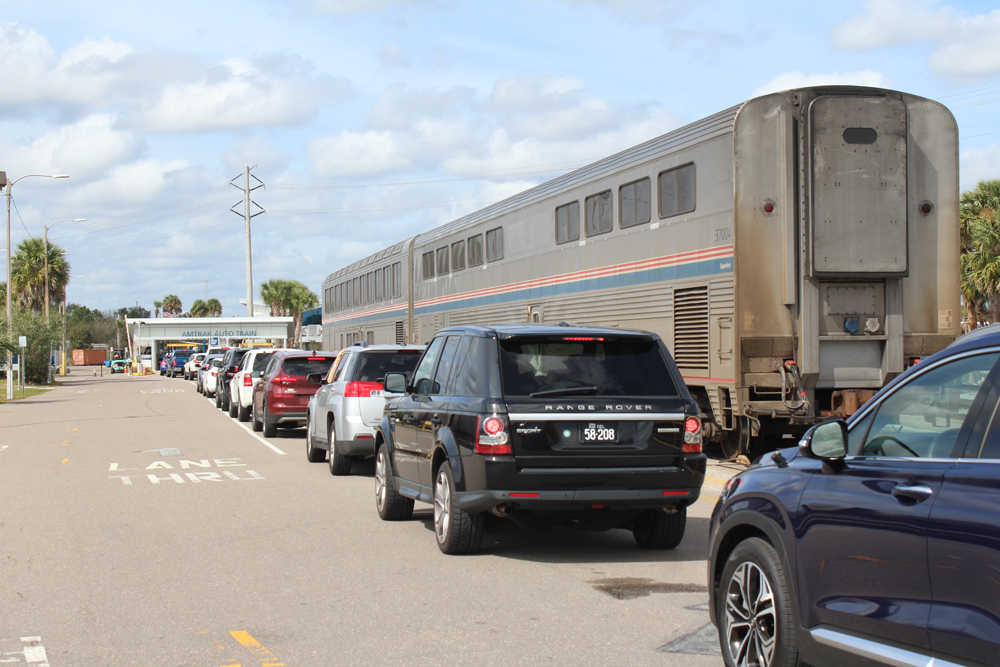
WASHINGTON — Amtrak’s fiscal 2021 results saw ticket revenue and ridership both off 63% from 2019, the last year when the October-September fiscal calendar was not impacted by COVID-19 travel restrictions and massive service cuts.
Long-distance trains, however, suffered less of a setback than state-supported and Northeast Corridor operations.
For the fiscal year ending Sept. 30, the company generated $882.8 million, compared with the $2.3 billion in 2019, according to data obtained by Trains News Wire. Combined ridership of long distance, state-supported, and Northeast Corridor service totaled 12.8 million passengers, compared with the 32.8 million carried between October 2018 and September 2019. Patronage plummeted with pandemic-related cancellations beginning in March 2020, so that fiscal year’s results were impacted by early and precipitous service drops, as indicated in the table below.
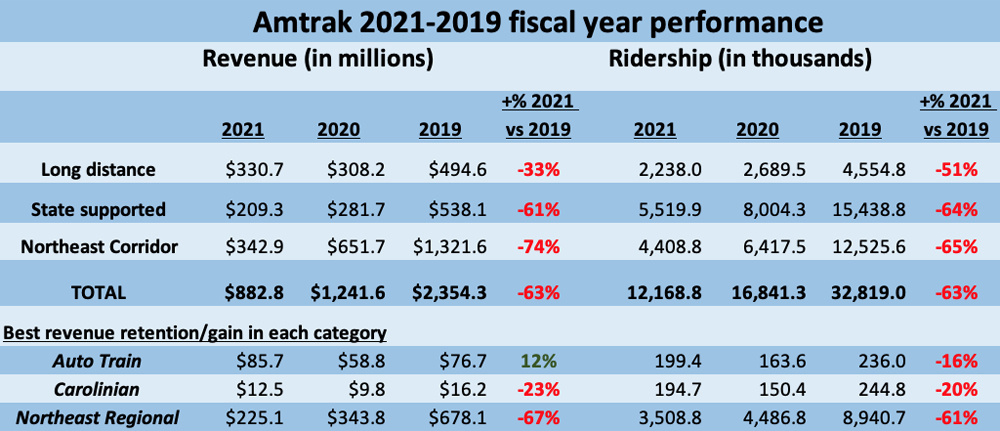
Breaking down the three service segments:
Long distance
This segment consistently outperformed multiple-round-trip corridors, despite reductions of 12 interregional trains to triweekly frequencies from October 2020 through May 2021, followed by constricted equipment assignments causing sold-out conditions on many routes during the summer. [See “Dining car access to be extended to Coast Starlight business class,” Trains News Wire, Sept. 23, 2021.]
Auto Train’s figures are especially noteworthy. It is the only overnight train Amtrak management maintained as a daily operation through the pandemic and separately promotes outside of company-wide fare sales. The Lorton, Va., to Sanford, Fla., service also dealt with reduced consists that limited coach and sleeping car capacity, but benefitted from the nationwide shortage of rental cars and exorbitant pricing for Florida autos.
As a result, it was the only segment of Amtrak’s business that beat fiscal 2019 ticket revenues, delivering $85.7 million in 2021. This helped offset challenges for the category elsewhere, such as extensive weather and fire-related cancellations and truncations for the Coast Starlight, Sunset Limited, City of New Orleans, and Crescent.
State-supported trains
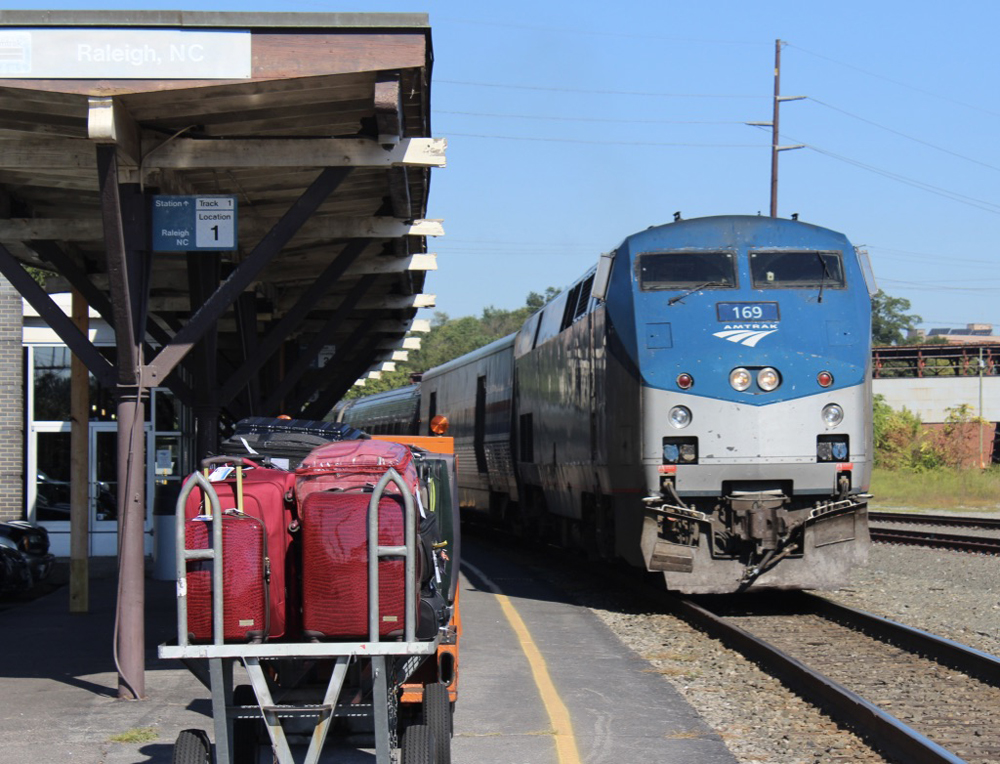
Services that historically relied on relatively short-distance daily commuter, school, or business travel suffered the most when operating authorities were slow to restore frequencies. Although COVID-19 relief funding provided a cushion against anticipated lagging revenue, most states and regional operating authorities declined to add more round trips until the late spring and summer of 2021.
With Canadian citizens still not permitted to cross the Canada-U.S. border (though U.S. citizens can now travel north), the New York-Montreal Adirondack, two Seattle-Vancouver, B.C. Amtrak Cascades round trips, and the Niagara Falls-Toronto extension of the New York-sponsored Maple Leaf are still sidelined.
It’s not surprising that this category’s big winner is the once-daily Carolinian. Traveling 704 miles, the New York-Charlotte, N.C. train sneaks under the 750-mile demarcation between state-supported and long-distance trains. That figure was established in 2008’s Passenger Rail Investment and Improvement Act to keep North Carolina paying to run the Carolinian while avoiding discontinuance of the 829-mile New York-Savannah Palmetto or the 780-mile Chicago-Washington, D.C. Capitol Limited if state funding failed to materialize.
Northeast Corridor
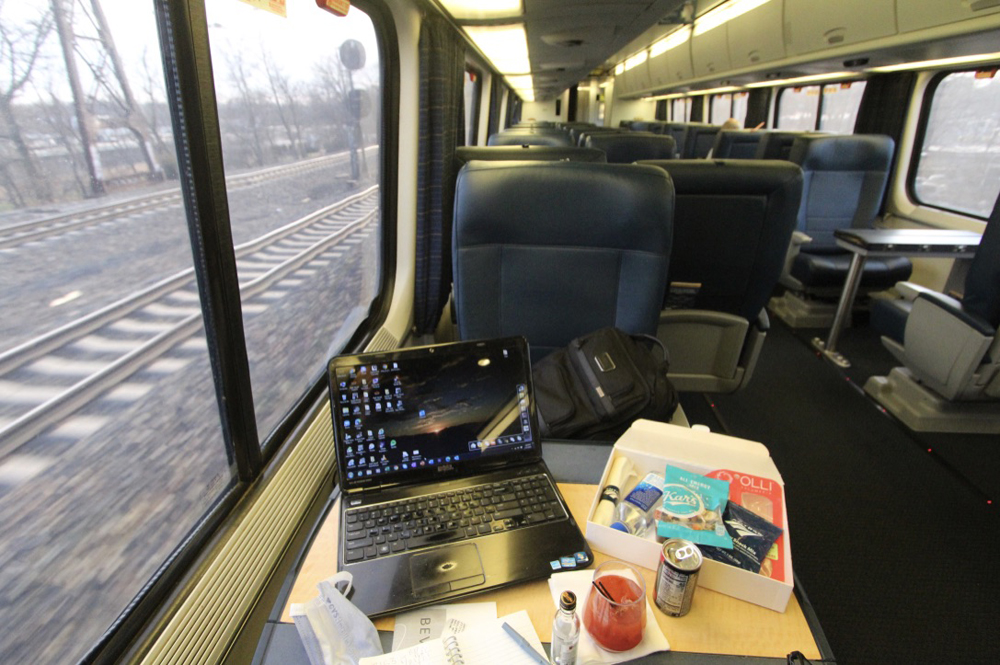
Even though Amtrak has been regularly restoring Boston-Washington, D.C. frequencies since June of 2020, both Acela and Northeast Regional revenues and ridership have suffered the most compared with 2019. They have been historically responsible for the lion’s share of the company’s revenue and capital investment, and thus have attracted significant attempts to stimulate demand.
While the “Ticket Revenue Per Rider” metric supplied by route with the monthly reports doesn’t show whether management is doing the best job possible in maximizing both indicators, it does reveal the relationship between demand, capacity, and pricing. Comparing 2021 with 2019, here is the change in the average fare:
Acela -27.8%
Northeast Regional -15.4%
All state supported +8.8%
All long distance +36.1%
The bottom line: with plenty of seats to offer, Amtrak has been able to lower Northeast Corridor fares to win customers who might not have otherwise chosen to ride the train, but that strategy doesn’t exist elsewhere on the system.
Trends
Despite a surge in COVID-19 cases toward the end of the summer (which caused flattening of results for state-supported and Northeast Corridor services), all categories have made steady gains throughout the year, as evidenced by comparisons illustrated in the table below:
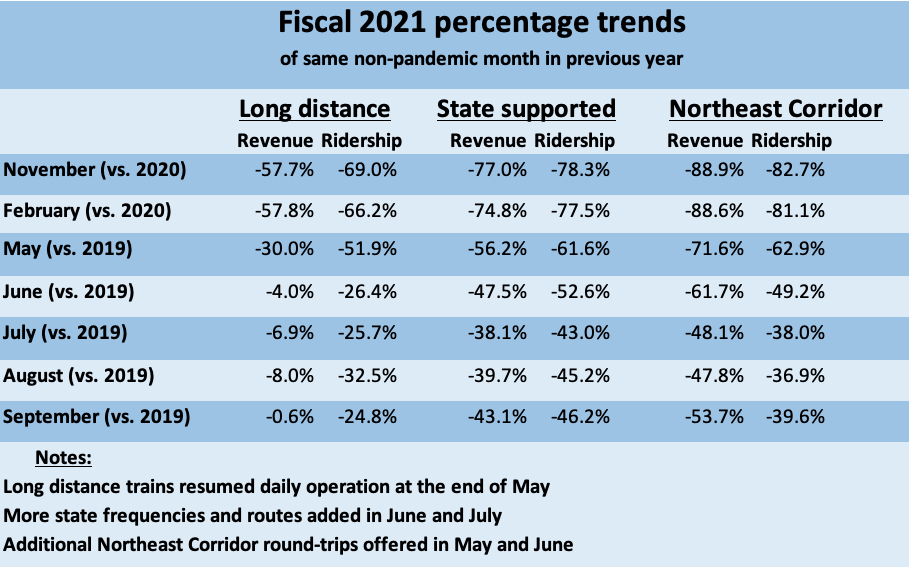
Even with limited long-distance departures and capacity, the strength those trains exhibit is clear. Additional frequencies to be implemented in late October on all three California corridors and those recently added in Virginia will soon help boost state numbers. And Acela First Class food has been enhanced in an effort to differentiate the product and justify higher prices for that class of service [see “Amtrak introduces upgraded meals in Acela First Class,” News Wire, Aug. 5, 2021].
Now it is up to Amtrak management to keep the momentum going by making enough equipment available at optimum price levels for everyone who wants to ride.














Maybe the reduction in NEC is due to commuters working from home and not riding the NEC to the office. The purpose for riding LD trains would be less affected. Few people ride the LD trains purely for utility.
In any case, with Amtrak’s black box, non-GAAP accounting, who can know which segment loses the most money?
Mr. Johanson, I don’t know anything about the travel market between Vancouver and Banff. But I do know that these one train per day LDs are a sad excuse for a passenger rail service. Taking a train my wife and I rode fairly frequently between 1984 and 2008, the Lake Shore, as an example, it is pathetic that in 50 years it hasn’t grown to at least two on the route on complimentary schedules. A NY-CHI with a Boston connection and a BOS-CHI with a NY connection would be my vision. But if it’s never going to happen with Amtrak and the host railroads mostly at odds on the issue of “priority handling” on main lines that haven’t the capacity or operational flexibility they used to have. Add to that the unwillingness of federal and state governments to fund capacity restoration to 1950 levels while for example Chicago O’Hare gets some $8b for expansion and you get, as I put it above, “a one-way ticket to Oblivion”.
This suggests that the LD trains have their market and that market might be slightly more protected against pandemic-related impact than the regional services that might have ridership that is more commute, business, school related.
Though that should not be interpreted as the LD network is better or has more growth potential than regional trains. It could be that it has its market and serves it well. Rocky Mountaineer does well, does not mean there should be 4x trains a day between Vancouver and Banff.
Yet the NEC corridor is getting its 2nd new gen trains sets while most of the LD equipment is older than what Amtrak got from the RR’s at its inception & their numbers are dwindling. Two slprs, two coaches & lounge down in one week the MT wrecks probably totaled out & no new equipment plan/designs even in the pipeline. When Amtrak uses up whatever $$ they get from the infrastructure investments & the political climate changes they will again have the target on their back with more LD cuts as the solution. This time will be easy dwindling LD equipment due to wrecks & cost of maintaining them will become unfeasible & will lead first to service curtailments then to total route eliminations they will finally be rid of those pesky LD trains. Nations budget deficit solved!!!
Galen, some time ago IIRC it was discovered the Acela 2 pantographs have tracking problems that would set their entering service back by at least a year. Someone please let us know if this is not correct. Regarding LD fleet replacement, yes it’s long overdue. And nothing has been done. But try to bring that up to even the politicians who claim to be so “supportive” of the LDs. They are perfectly comfortable with the fact that the commercial aircraft Charles flies, the intercity buses some of us might ride where Amtrak doesn’t go or go often enough, and the autos most of us drive are not the same as the ones as when the Superliners debuted. But the eyes of those same pols will glaze over if you try to ask them why Amtrak won’t replace the cars that are, as you point out, older than the cars they inherited at startup. Why? Because they don’t ride. They never have, they do not now, and they never will except perhaps for a photo op. Add to that an Amtrak President who believes NEC=Northeast Corridor=Nothing Else Counts. And no one cares enough to get rid of him. Those Amtrak “supporting” pols don’t even know the names of the company’s CEO and President. They said nothing when it became evident that the present CEO’s predecessor was using a wrecking ball rather than building blocks. It all adds up to a one-way ticket to Oblivion.
Yes the Acela II pans do not track well. They are French. There are US-built Acela I pantographs that do track well.
As to replacing the Amflet cars, is there really something better? Were the rebuilt 21-roomette cars of 1964 with half the windows of a coach better than the 1927 built and 1948-1952 rebuilt P70fbR’s?
When you replace equipment it’s supposed to be with something better.
Curiously, NEC revenue way down compared to LD revenue. We were told LD was the loss leader. Now, seems not to be the case. I hope for increased LD offerings.
1. FYI, the Carolinian photo is a northbound #80 at the old Raleigh station.
2. The capacity of limits on the long distance trains almost makes it appear that Amtrak is trying to make them look bad, so the short distance corridor declines don’t look so bad in comparison.
The article does not mention sleeping car ridership/revenue vs coach ridership/revenue for the LD trains. Are people getting traveling in sleepers in order to social distance? Would day trains benefit from private space? Would this continue after the pandemic ends?
LANDON – I can only speak for myself. Social distancing in my mind is witchcraft, nothing more. You should see the airplanes I ride in, or how crowded the airports are. Doesn’t bother me. Being around other people in close contact doesn’t bother me and never has. Ever ride the Green Line in Boston? Belly to belly standing on tiptoes. Fine with me. I never caught a disease on the Green Line which was far and away more crowded than the crowds some people now avoid.
In general, I fly because I have to (to see family) and in general I take Amtrak for leisure trips by choice. (Like day trips to a Chicago museum.) So I put up with masks on the airplane, but will stay off Amtrak until the mask requirement goes away (if ever).